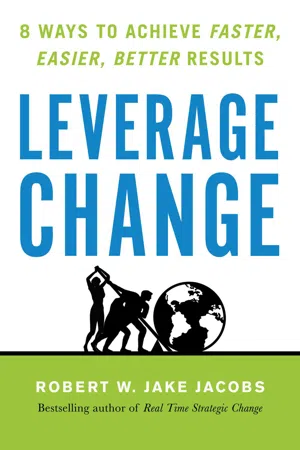![]()
PAY ATTENTION TO CONTINUITY
Change, change, change. It’s all you hear about. When it’s time for organization change, banners are unfurled, communications teams go into overdrive, leaders ready their stump speeches. The promise of a better, more exciting future and healthier culture lies ahead. The company will be more competitive in the marketplace. Smarter ways of working will take hold. Everyone will be pulling together toward a common cause. Assurances are made. Resources are devoted to making things different. Confidence is stoked and enthusiasm encouraged. Momentum builds … until it doesn’t. All the hype, pomp, and circumstance run into the buzz saw of reality. Resistance mounts. People complain about wanting to return to the “good old days.” New ways of working fall by the wayside. The organization regresses to business as usual. Time marches on.
A Common Problem: There’s Too Much Change
Extraordinary amounts of time and care go into crafting “cases for change.” All the reasons get listed in compelling detail. The arguments are persuasive. The language is crafted just so, meant to further motivate those already on the bandwagon and convince fence-sitters to come along. Common wisdom says not to focus on the strongest in opposition. They aren’t likely to get on board anyway, and you don’t want to waste precious resources. People are encouraged to identify the various changes required to make the effort successful. The spotlight is focused on what will be new and different. The change campaign is under way.
Sometimes this approach works. Often it does not. Why is this so often the case?
Solution: Pay Attention to Continuity
A major reason most change work falls short is that you’re dealing with only half of reality. Whether people realize it consciously or not, they know there’s something wrong with this picture. You’re clapping with only one hand. What about a rousing chorus for a “case for continuity,” highlighting all those things from the past and present that need to be part of your organization’s successful future? The firmer the ground people stand on, the more able they are to push off in their leap into an uncertain future. Radical continuity makes radical change possible. Welcome to the world of paradoxical change. If you want change, don’t (just) go after change. Remember and celebrate the importance of continuity, and you’ll be well on your way to achieving successful change.
My friend and colleague Barry Johnson has studied and taught the concepts of paradoxical change for more than forty years.2 His original and still growing body of knowledge is the foundation for this chapter. He views the power and possibilities of paradoxical change through a lens he calls Polarity Thinking™. Polarities are opposites that need each other over time to succeed. Take breathing as an example—inhaling and exhaling. Consider activity and rest. Both contribute to a healthy, balanced life. Organizations wrestle with all kinds of polarities every day. Do we focus on our business unit’s success or on the entire enterprise’s fortunes? Would we be better off centralizing shared services for efficiencies or decentralizing them to get closer to the customer? Is it smarter to go after profit today or potential for tomorrow? The best answer to all these questions is yes.
Approaching change from a paradoxical point of view transforms your greatest resisters into your staunchest allies. We know how to deal with resisters in a traditional approach to change: leave them behind. They’ll either go quietly or get louder. Neither reaction is productive for moving the ball down the field. Push on them to change their views, and they push back even harder. Not only despite your best efforts but in fact because of them.
The rules of the game change when you’re dealing with paradoxes and polarities. Instead of outvoting the minority, understand that the fewer the people who share a point of view and the less powerful they are, the more you need to listen to them. What they see and believe, others don’t. Their being the minority doesn’t make them wrong. It makes them even more valuable potential contributors. Rethink what these resisters have to offer. In many cases, they see traps that you can overlook in your excitement to move forward. Within a polarity paradigm, there is wisdom in resistance. It’s not an obstacle to be overcome or gotten around on the way to an exciting future. It’s a point of view that you need to include to get to that exciting future.
People with an “Or” mindset get stuck in useless debates about whether the organization needs to focus on change or on continuity. Will things be better in the future because we decide to do things differently, or should we stick with the tried-and-true practices that have gotten us to where we are today? The answer to this question is a firm yes. Each of these groups is right. The problem is that each is only half right. You only get the complete answer by coming from an “And” point of view. Both continuity and change are needed for either to be successful.
Challenge your existing assumptions about what makes for successful change. Adopt a paradoxical approach and be prepared to be surprised by the ease, speed, and quality with which your efforts move forward. It’s the first of our 8 Levers because it sets a context for the rest. Leverage means getting more done with less. Less resistance. Less time. Less wasted energy. A paradoxical approach to change is your first step on that journey.
How This Lever Helps Create Faster, Easier, Better Results
The Pay Attention to Continuity lever leads to new thoughts and behaviors. You move from defining the people who are resisting change as problems to creating an expanded team where everyone’s voice is heard. You want to use this lever in your change work for the following five reasons:
1. This lever reduces resistance to change from those valuing continuity. The greater the resistance, the slower your change. People may argue that there are methods that have served them well in the past. Great. What were they, and will they help us move toward our preferred future? Others extol the virtues of parts of the culture they don’t want to lose. Super. Let’s identify and preserve the aspects that will work going forward. You’ll hear arguments that even though roles are changing, key performance indicators for the institution should stay the same. Exactly. What’s worked before can work again. Even when people are holding on to outdated practices that won’t serve them well in the future, listen. Dig deeper to understand why they’re still holding on. Resist the urge to dismiss them. You’ll be wiser about why things haven’t worked and have less resistance pushing against you.
2. It ensures that you benefit from past practices that will serve you well in the future. There are plenty of ways you’ve worked in the past that have been effective. You’re never starting from scratch when it comes to change. The difference is that this time you’re making no assumptions. Consciously pay attention to what’s gone well in the past and be sure to bring it forward into the future. Don’t leave it to chance that these points will be made. Identify anything and everything from the past that has been successful. Let nothing get lost in the shuffle. What’s worked is good for your future. What needs to change can lead to even better solutions. Take your pick of the most important aspects that need to be retained in your situation and emphasize them. Here’s a starter list to consider:
• Teams that work together
• Where they work
• Tools they use
• Groups with whom they interact
• Customers they serve
• Suppliers they partner with
The possibilities go on and on. Next time someone talks to you about a big change, be smart enough to also ask about the big things that will continue just as they have from the past.
3. You’re clear and strategic about what to continue from your past. When you’re clear about what you want to continue from the past, you’ll build a more accurate list of what you need to change. Typically, people decide what to change. What doesn’t make the list ends up staying the same. This isn’t a conscious or considered process. Give as much time and attention to what you’re going to continue doing as to what you’ll be doing in new ways. What you continue from the past will have as much impact on your future success as what you decide to change.
4. You build one large organization-wide team valuing both continuity and change. No one gets left off this team. Everyone is valued for their unique perspective. Some people will be natural traditionalists and favor the best of the past and present. Others will inherently focus on innovation, always on the lookout for new and better ways of working. These two camps need to get used to getting along. Their battles have likely been waged for years. Adopting a paradoxical approach to change eliminates conflict between the two groups. Neither is “right” or “wrong.”
5. You stand the best chance of achieving your ultimate purpose. Regardless of what you are trying to accomplish, you’ll be worse off for not applying this lever. Continuity and change each brings its own engine to creating your future. Pay attention to only one, and you’re working with half the power you have available. Doing a good job on change and dropping a few balls on the continuity side of the equation will cost you dearly. Without careful and consistent attention to both continuity and change, you’ll sell yourself and your organization short. Customers will be disappointed. Quality numbers will suffer. Financial forecasts will fall short of the mark.
Success Factors in Applying This Lever
A paradoxical approach requires new assumptions and beliefs. Make changes to your own paradigm, and you can lead others down a similarly helpful path. The success factors that follow are the rules of the road for this new world of possibilities.
Factor One: Adopt a Paradoxical Point of View about Change
You have to see change for what it is—half the equation. Going after change to create more change … will create less. You’ll build your own resistance. People getting in the way of your grand change efforts have made your job harder since day 1, putting up roadblocks that slow your best efforts. Maybe it’s you who’s had it wrong all along.
Once you see change paradoxically, you can never see it another way again. Leverage is not found in pushing harder, arguing louder, or holding on to your position longer. There’s a new set of rules to follow. Seek out the old guard and have them tell you stories of the good old days. Let go of your beliefs about these folks being past their expiration date, out of touch, and behind the times. Assume instead that they are your best friends, bringing nuggets of wisdom to the table—nuggets you would have ...

